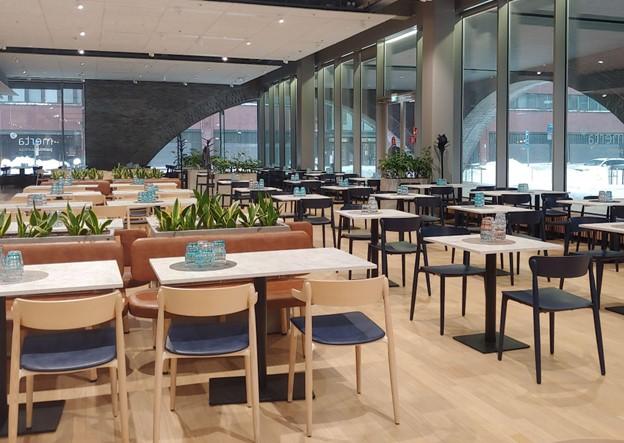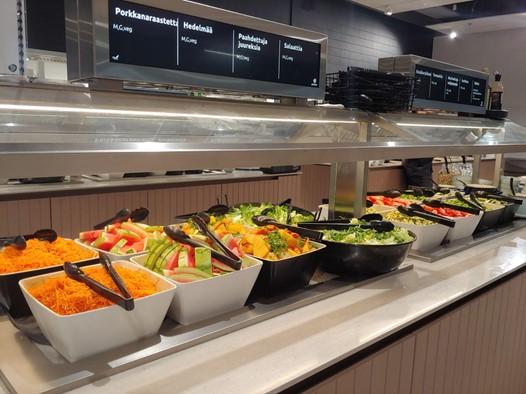Procurement category: Food & catering
Environmental impacts targeted: Diverse, attractive and variable food selection, CO2 reduction, responsible food or restaurant services production
Relevant EU legislation/policy/guidance: EU GPP Criteria on Food, Catering Services and Vending Machines
Background
The Helsinki City Strategy 2021-2025 sets out ambitious climate goals for the city, including a 2030 deadline for achieving carbon neutrality, a goal to attain carbon zero status by 2040 and an intention for planning a carbon-negative future. To reach these objectives, several food-related actions have been identified, such as reducing food waste, managing surplus food and establishing climate criteria for food and meal service procurements.
In 2020, the City of Helsinki opened its Urban Environment House to agglomerate its approximately 1,500 employees in the urban environment sector into a single office building. As the new space hosts a restaurant service on the entrance floor, which is open to both staff as well as external customers, the city aimed to include sustainable criteria in its procurement of such services. The tender was conducted as a pilot procurement of the Towards Carbon Neutral Municipalities and Regions (Canemure) project, a six-year initiative that promotes regional climate action in Finland.
Procurement objectives
The City of Helsinki sought to acquire restaurant, cafe and catering services for the Urban Environment House that were diverse, attractive, variable and considerate of potential environmental and climate impacts - particularly the city’s climate neutrality objective, and responsibly produced.
Prior to tendering, detailed research on the requirements and characteristics of the service was conducted. The contracting authority cooperated with several parties, such as an external consultant specialising in the catering sector familiar with tendering materials, experts from the Canemure project of the city’s Environmental Services division knowledgeable on climate impacts and climate responsibility, and an expert from the Finnish Environment Institute (SYKE in Finnish) knowledgeable of carbon footprint calculations. Additional intelligence was derived from the City of Turku’s experience with calculating the carbon footprint of their food services.
Tender requirements
To meet the city’s climate ambitions, green considerations were integrated into the technical specifications, award criteria and contract performance conditions of the tender. The call for competition reflected the goals of the city and was based on desk research, consultations with other organisations and procurers who had tendered similar services and a guide for responsible food procurements. The criterion for a carbon footprint calculation was based on conversations with the expert from SYKE.
The service requirements clearly describe that the Urban Environment House restaurant service provider should be a “responsible pioneer, aware of the environmental and climate impact of the service, and environmental impacts in its operations and communicates responsible choices to its customers”. In that respect, the tenderer must have at least three years of experience producing restaurant services in the same scope and subject of this procurement and have a customer feedback system that has been in operation for at least 12 months.
While the healthiness of meals and compliance with recommendations from the National Nutrition Centre offered a starting point for the design of the menu, the restaurant was required to give preference to climate and environmentally friendly ingredients and recipes.
The technical specifications included a range of environmental, health and social requirements, such as:
- The restaurant offers a wide range of vegetarian and vegan options. The lunch menu must include at least two vegetarian dishes per day, one of which is vegan and the bistro’s à la carte meals must include a vegan or vegetarian dish at least once a week.
- The restaurant favours climate and environmentally-friendly ingredients from which recipes are developed and attempts to identify substitutes for products with a significant climate impact.
- The origin of meat is indicated on the restaurant’s menu and the service provider is able to provide information on the farm location where the animals were reared, slaughtered and where the meat was processed and packaged.
- The species of fish available in the lunch options are restricted to those not marked with a ‘red traffic light’ (i.e., “unsustainable fish that are poorly managed or not managed at all, and/or from endangered or depleted stocks… [or] associated with high or unacceptable environmental impact”) by the WWF Fish Guide.
- All vegetarian and vegan foods follow nutritional recommendations and use good sources of vegetable protein and other raw materials suitable for a vegetarian diet. Additionally, nutritionally well-balanced, attractive and modern vegetarian and vegan recipes will be developed to nudge omnivores towards choosing a vegetarian option.
- Preference for vegetables, root vegetables and fruits is given to seasonal crops.
- Efforts are taken to reduce food waste and leftover food, e.g., through good planning and attractive presentation. Leftover lunch food is sold by the restaurant at an affordable price.
- Take-away products use environmentally friendly packaging materials and recyclable disposable containers from renewable sources.
- The café should offer Fairtrade (or equivalent certified) coffee and tea, as well as other Fairtrade (or equivalent certified) products on demand.
- During the contract period, the service provider must employ at least one (1) person in a weak labour market position for work related to the object of the procurement.
The bids were weighted at 30% by total price, 65% by qualitative criteria and 5% for the turnover-linked additional rent offered by the tenderer on top of the fixed rental rate. The six qualitative assessment criteria were:
- (Max. 20 Points) The service provider’s proposal on the a) concept and operating model of the restaurant and café, b) personnel, c) deployment plan, d) substitute arrangements and e) orientation process.
- (Max. 10 Points) The qualifications applicable to the field and work experience of key personnel assigned to work as well as the experience of the key personnel with development and innovation.
- (Max. 5 Points) The service provider’s commitment to employ two or three persons in a weak labour market position during the contract period. This includes the long-term unemployed, young people, immigrants, people with disabilities and people with partial work capacity. As stated in the technical specifications, the tenderer must employ at least one person from a vulnerable labour market position (0 points). To receive full points, the tenderer will employ at least three people in a vulnerable labour market position (5 points).
- (Max. 5 Points) The service provider has implemented ISO 14001, EcoCompass or any other environmental system verified by an external party in which the organisation a) has set environmental objectives, b) implements an action programme in order to achieve the objectives, c) monitors the implementation on a regular basis in order to achieve the objectives and d) continuously improves the environmental performance of its operations by setting new objectives.
- (Max. 20 Points) Results of a customer satisfaction assessment as well as a review of the restaurant’s lunch offerings by a taste panel consisting of personnel of the urban environment sector.
- (Max. 5 Points) Overall grades of service provider’s Oiva reports. Oiva reports are publicly displayed documents received for an inspection carried out by the food control authorities on food premises.
According to the contract performance conditions, the service provider must assist in determining the carbon footprint of the restaurant service by using a calculating tool for food services developed by SYKE. This calculation may be used to set possible targets, measures and monitoring plans under the contract.
Results
The procurement was carried out through an open procedure. The contract duration is five years, and the total value has been estimated to be approximately EUR 7.5 million. The restaurant is named Restaurant Merta and is fully operational.
The qualitative criteria were credited as essential to the procurement process. Four bids were received and, in the end, the provider Palmia was selected. The winning bid received full points for environmental responsibility (ISO 14001 certified) and for committing to employ two or three persons in a weak labour market position during the contract period.
In addition to the carbon footprint calculations of the food served in the restaurant, the case resulted in a new specialised calculator, which is suitable for more accurate daily carbon footprint calculations in restaurants and canteens. The Excel-based tool is publicly available for download (only in Finnish).
Environmental impacts
According to the ‘EU Green Public Procurement Criteria for Food, Catering Services and Vending Machines’ the key environmental impacts of food service procurement are associated with food production, and centres on energy, land and water use. This aligns with the finding from the SYKE’s carbon footprint calculation of food services in the City of Turku which found the largest source of total emissions was the production of ordinary mixed food (84%) and food waste (10%). Other environmental impacts include the production and use of pesticides and chemical fertilisers, the depletion of fish stocks, the emissions of pollutants such as methane or nitrites from farming and agriculture activities, the use and pollution of water and the disposal of waste.
This contract addresses these concerns by requiring the calculation of the carbon footprint, favouring environmentally friendly raw materials, restricting the use of unsustainable fish, accounting for the meat production and process and reducing food waste through, for example, good planning. A carbon footprint calculation was performed based on the data of two monitoring weeks of August-September 2021 which collected data on prepared dishes per recipe, food waste (both plate, kitchen and serving waste), served side dishes and the daily number of visitors (see Figure 1).
The calculation found that customer-specific carbon footprint for the time covered was 2.20 kg CO2e. Food waste accounted for around 3.2% of the footprint while the carbon footprint of a vegan meal was on average less than 40% of that of the meat meal. From the smallest to the largest carbon footprint by meal set included vegan a la carte, vegan food, vegetarian food, fish food, a la carte and meat food. The study concluded that there are large differences when comparing the carbon footprints of different meal packages and that the restaurant should both offer low-carbon meals as well as offer customer price or other incentives to choose such dishes.
A full report (in Finnish) on this carbon footprint is also available.
Lessons learned
- While findings from the SYKE’s calculation of the City of Turku’s food service were used to set the responsibility requirements for the service provider, the previous tool was unable to calculate the emissions from specific dishes and did not provide enough details for a comparison of bids during the tender evaluation stage. During the contract, a new calculator was developed.
- The consideration of environmental and climate impacts remained separate during the tender preparation stage. Allocating enough time to prepare the tender and increasing cooperation could have facilitated the setting of common objectives and the defining of contract requirements.
- The city lacked clear guidelines on how the food service industry could address its ambitious climate targets. This could have been improved through the availability of comprehensive instructions.
- Increased preliminary market and user engagement would have been beneficial to better define feasible and usable criteria.
- The consultation of external expertise and insights from city partners (such as Turku) was helpful for developing the tender as the contracting authority was not starting from scratch.
- Looking ahead, the city has introduced the Food Waste Ecosystem project in order to address the wider issue of food waste in city services.
More information
For questions, you may contact the Urban Environment Division.
Relevant EU legislation/policy/guidance: EU GPP Criteria on Food, Catering Services and Vending Machines



